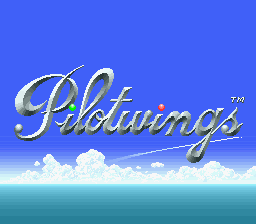
Developer: Nintendo
Publisher: Nintendo
Release Date: August 23rd, 1991
Genre: Simulation
System: Super Nintendo
Before the release of the Super Famicom there were tons of screenshots for upcoming games printed in Electronic Gaming Monthly. It wasn’t Super Mario World or F-ZERO that caught my eye, it was Pilotwings. I’ve played Mario and racing games on my Famicom, so I wasn’t really as impressed with those games as I was with Pilotwings. The graphics looked so cool and I just couldn’t wait to play it.
Upon receiving the game, I played it for hours. I was blown away by the Mode 7 effects and the 16-bit graphics. To me, at that time, the graphics of the SFC was better than the Genesis. I think it had a lot to do with the Mode 7 effects. I was totally in awe. My poor Genesis was ignored for a good, long while.
So you are a student in a flight school (“Flight Club”) and you must complete a series of tests to earn certificates. Your first lessons include piloting a biplane and skydiving. The rules are simple. Just fly through some rings or touch a pattern of balloons, then land safely in a designated area. The first three missions of the game are to introduce you to the 4 different types of flight instruction: biplane, skydiving, jetpack, and hang glider. Your goal is to get at least a set minimum given by each instructor. For example, your minimum for the first level is 120 points out of a possible 200.
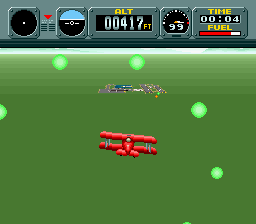
There are 4 flight instructors and their names are different in the English and Japanese versions of the game. Three of the four instructors are ethnically Japanese apparently, but I just don't see it in Big Al. Anyway, their names are (with their JPN version names in parenthesis): Tony (Fumiya Tanaka) for Levels 1&5, Shirley (Ran Shiraishi) for Levels 2&6, Lance (Indy Scott) for levels 3&7, and Big Al (Doubei Kuroda) for levels 4&8. Each instructor has their own personalities based on the level you are on. Doubei Kurodo is strict and stern while Ran Shiraishi is encouraging and positive. Fumiya is easy on beginners and Indy is a bit of a introverted “foreigner”. The funny thing about the Japanese version is that the Lance (Indy Scott) plays an exaggerated token foreigner-in-Japan character. The manual states his Japanese is "fluent" but he talks like a baby speaking broken Japanese. I was a bit surprised to see this in a Nintendo title, but it encompasses all Japanese, I think.
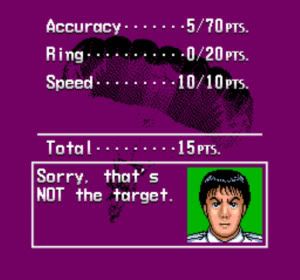
In the Biplane or “light plane” stage, you pilot a small airplane around an airfield. Your goal is to either follow a string of balloons, touching them as you pass, or to go through rings set around the field. Upon completing this objective, you must land safely and properly. If you land too hard or off the runway, your plane will crash and you will fail the mission. In the early levels the plane starts off airborne, but in the later stages you must control its takeoff as well as its landing. On the top of the screen you have an available altimeter, radar, and other instruments to help you navigate. These tools are also available in the other events.
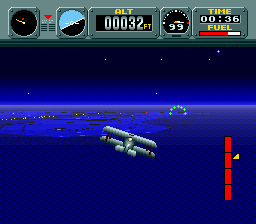
In the skydiving stage you are taken high up into the sky via helicopter and dropped. You can control your character by leaning forward, backward, and spin 360 degrees. As you fall freely you are to fly through a series of rings to score points. After entering a certain altitude, you are prompted to open your parachute. After your parachute deploys you are given control as to which direction it can go as well as drop speed. If you drop too quickly, you will get injured and points will be deducted. You must land in the designated area to receive points. If you do not open your chute your character will just slam into the earth at free-fall speed causing him to puncture a hole in the earth’s surface, possibly landing in hell. Eek!

In the rocketbelt stage you must maneuver around the airfield flying through rings or touching balloon bars. The A&B buttons control the strength of propulsion of your rocketbelt. You also have control of yaw and camera angle, overhead or rear. This is the most fun part of the game, in my opinion. You can do all kinds of funny stuff if you get bored with the objectives. Complete all objectives, and then land in the designated area (bull’s-eye).
I remember when I was a kid and I brought this game to my friend’s house to play it. We were playing and his dad was sitting on the couch watching us. When the rocketbelt stage began, he immediately started laughing. We asked him what was so funny; he said that the music sounds like 1970s indie porno music. That has been forever seared into my mind. Just thought I would share that little anecdote.

Lastly, there is the hang-glider stage. This is the most difficult of the four. Your goal is to reach a specific altitude, then land your glider. It is much easier said than done. The hang glider stage is also, in my opinion, the best stage that gives you a great sense of flight and speed. It really stands out. When you hit the up current winds, you ascend then suddenly dip down, facing the earth below. This really feels like you are flying in a 16-bit world.
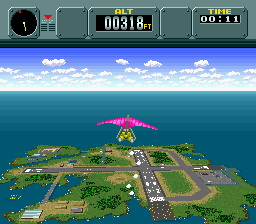
Upon completing these 4 events, you are sent on a rescue mission. Your mission is to pilot a helicopter deep into enemy territory to rescue your flight instructors, escape safely, and land back on base. Wait a minute…WHAT?!? I just finished flight training for a biplane, skydiving, jetpack, and hang glider and now they want me to pilot an aircraft for which I had no prior training for and fly it in a combat operation, another thing for which I have had no prior training. Sounds just about right! Anyway, so the helicopter stage is played upon completing the 4th and 8th levels of the game. Complete the first helicopter stage and you will unlock the ultimate in Pilotwings piloting, Pilotwings Expert. It also has a different title screen to remind you of your awesomeness.


There are also bonus stages which you can unlock if you land on the moving platforms. The bonus stage varies depending on which level you are at in the game and which event you used to access the bonus stage. The bonus stages include penguin diving and bird suit flying, among others.
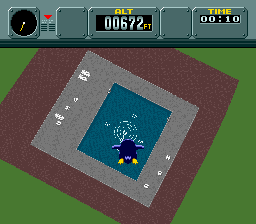

Of course you must take a break while playing this game, so you are given a password option. Upon completing each level you are given a certificate of completion. On the bottom of this certificate is a serial number which is also your password. So write them down as you progress just in case your power goes out or you pass out from the dizziness brought on by the awesome Mode 7 effects.
I own both the SNES and SFC versions of the game. There are minor graphical differences that don't make much of a difference. Of course, the language is also different. The instruction manual for the SFC version is a bit more detailed, even where details are not needed. It even has a section in the back hinting that this flight club is some secret, shadowy organization. I think it’s just going too far.
The Verdict: 8/10
This game was released to show off the Mode 7 capabilities of the Super Nintendo, and it executed it very well. They could have just released a game with Mode 7 effects and little else and it would have still sold, but they took the time and effort to create a game that is fun and challenging. It is a great game, but not perfect.
The game really gives a great sense of speed, depth, and motion given the technology at the time it was developed. I think the hang gliding stages allow you to feel these things greatly. The music and sound effects also help this effect even more. The instruction manual (SFC version) highly suggests that you use headphones while playing this game because it creates a sense of really being out in the open sky. Wow, Nintendo is really confident in their games! It also tells you this only happens if you use the AV cables and not the RF connection. What a bummer for the kids whose parents couldn’t afford newer TVs back in 1990.
The only gripe I have about this game, which is not a big gripe, is the lack of variety of vehicles/modes. They could have incorporated the helicopter as one of the events. But I guess if you count the bonus stages, there is enough content in the game to keep you busy.
I really enjoy this game, and it could possibly be because it is very nostalgic for me since I have owned it since its release. For those of you not from the 16-bit era, you may have a hard time getting into this game. Try to overcome this obstacle because you would be robbing yourself of a great experience. On top of that, it is cool to see what console game was considered a technological marvel of its time.
Since Miyamoto was involved (producer) with this game, it is no mystery as to why it’s great. There is no reason any Super Nintendo fan to not own this game. Even if you are not into flight simulation games, this game makes it fun and addictive. This game is easily available for very cheap, so buy it today! It is also available on the Virtual Console!
When Pilotwings 64 was released, I was just as impressed with it as I was with the original title. And you guessed it, which was my first N64 title. I have waited forever for another Pilotwings game; it looks like that wait has paid off as the next Pilotwings game will be released next year for the 3DS.
No pirates or emus!


No comments:
Post a Comment